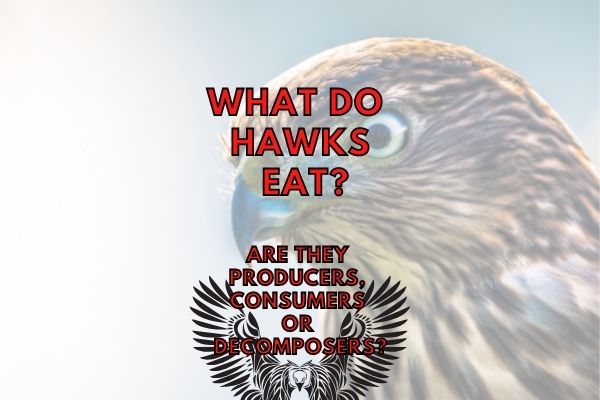Hawks are carnivorous birds of prey that hunt small mammals like mice and gophers. They are at the top of the food chain in their ecosystem and play an important role in controlling the population of these small animals.
Hawks are carnivores and tertiary consumers, which means they exclusively eat other animals that are primary consumers (herbivores) and secondary consumers (carnivores/omnivores). In addition to eating living animals, hawks also behave as scavengers by eating dead animals and carrion.
Hawks have sharp talons and beaks that help them kill and eat their prey. Their eyesight is very keen, allowing them to spot prey from far away. When a hawk spots its prey, it will swoop down and grab firmly onto it with its talons before killing it with a powerful bite from its beak.
Contents
Habitat of the Hawk
Hawks live in forests, fields, and deserts.
Hawks are large diurnal birds of prey with high-set, thin, spear-shaped wings adapted for fast flight and low maneuverability.
They usually hunt for prey by flying rapidly over a given area, watching for their prey to fly or hop into the open, and then attack it.
The hawks may also attack their prey while soaring in the air. Hawks have sharp, powerful talons for catching, tearing, and dragging their prey.
Hawks are birds of prey that feed on animals. Hawks are important predators in our environment. They can eat a wide variety of animals, including mice, gophers, sparrows, and rabbits.
Primary Diet of a Hawk
Hawks are carnivores. They eat mice, gophers, sparrows, and rabbits. Hawks eat small mammals, birds, and reptiles. They hunt by soaring in the air, then swooping down to catch their prey.
Some of the most common food items eaten by hawks are:
- Mice
- Gophers
- Other rodents
- Lizards
- Sparrows
- Finches
- Other smaller birds
Feeding Habits and Digestion of the Hawk
Hawks have sharp talons that make them powerful hunters. They grab their prey with their talons, then bite it with their beak.
The hawks beak is sharp enough to tear flesh. When the prey is secured they slowly rip off the flesh and swallow the pieces whole.
They do not have teeth, so all processing takes place in their crop and stomach.
Are Hawks Carnivores, Herbivores or Omnivores?
Hawks are carnivores because they primarily eat animals. Hawks do not eat plants, fruits or vegetables.
They evolved from a long line of terrestrial lizards who, similarly, did not eat any plants. Even pet hawks will never eat plants.
Sometimes, they may get plant matter in their gut because of the herbivore prey they ate, but this is consumed unintentionally.
Is a Hawk a Producer, Consumer or Decomposer?
Hawks are consumers because they eat other living things. Hawks are carnivores, which means that they eat other animals. Only plants as well as some bacteria and protozoa are producers.
What Type of Consumer is a Hawk?
Hawks are tertiary consumers because some of the animals eaten by hawks also eat animals themselves!
Generally, herbivores are primary consumers, omnivores secondary consumers and predators are tertiary consumers.
Can Hawks be Considered Scavengers or Decomposers?
Whereas hawks may occasionally eat dead animals or carrion, they are not considered decomposers, but are sometimes considered scavengers.
Hawks and eagles will all eat dead or dying animals if given the chance. They will not only seek aout dead animals like vultures do but they will not let a fresh carcass be untouched for long!
However, if the hawk spots another scavenger like a wolf or a vulture near a delicious carcass, it will not attempt to compete with the bigger scavengers out there. But if a smaller animal like a raven or a magpie was there first, it will not hesitate to join or scare them away.
Where are Hawks in the Food Chain?
As predators, hawks sit at the top of the food chain and are considered tertiary consumers. The vast majority of a hawk’s diet is composed of small mammals like rodents and birds, but they may also eat other hawks or owls that themselves consume animals.
Hawks are one of the most important predators in some ecosystems and are very important for the survival of other animals. They are the main predator of rodents, reptiles, amphibians, and small mammals.

By doing this they play a role in controlling insect populations, especially at times when insect populations are low.
They also provide protection of some animals and serve as a food source for other animals. Hawks are also important for the survival of medium sized songbirds.
Are Hawks Autotrophs or Heterotrophs?
Hawks are heterotrophs because they eat other living organisms. Practically no animals are autotrophic because animals do not get their energy directly from the sun like plants do.
That is, animals like the hawks do not make their own energy, but need to eat other organisms as their energy and carbon source.
What Animals Hunt and Eat Hawks?
While hawks may be at the top of the food chain, they are not without their own predators. Some of the most common predators of hawks are foxes and raccoons, but also larger birds like eagles, other hawks and owls will hunt and eat hawks for food – especially if already injured!
Humans also pose a threat to hawks through hunting and habitat destruction.
Conclusions
In this blog post I have looked into the diet of the hawk and how they feed on animals including sparrows, mice and gophers.
Hawks are a group of birds that are often associated with the hunting of small birds. Hawks have a very varied diet, but small birds are a large part of their diet.
If you are interested in reading about the local birds in your country or state, check out my section on backyard birds in the top menu!




